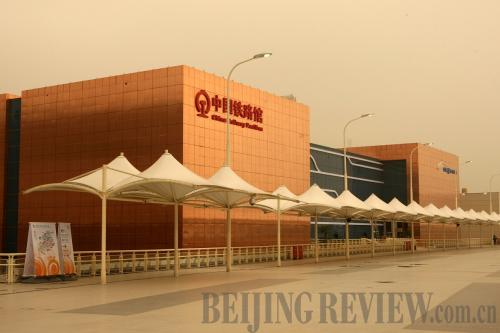|
|


ADVERTISEMENT
Buy Your own advertising
spaces!
.
Download Adobe Acrobat Reader to open [PDF] files.
Recent Visitors
Better Rails, Better Life
2010. 24 May
 The China Railway Pavilion is one of the most popular pavilions at the 2010 World Expo, drawing more than 4,000 visitors a day
The China Railway Pavilion is one of the most popular pavilions at the 2010 World Expo, drawing more than 4,000 visitors a day
by Hu Yue
(bjreview.com.cn) At the ongoing World Expo in Shanghai, the China Railway Pavilion is one of the technological masterpieces stunning the visitors.
With the theme "Where There Is a City, There Are Railways," the 3,690-square meter pavilion proudly displays the latest achievements and innovations of China's railways, and provides fresh insight into how railways have influenced human civilization.
The inside exhibition hall of the pavilion is interwoven with LED lights that glow on a huge glass wall, giving the impression of a bustling railway network facilitating urban transportation needs and modern lives.
"I spent a whole day at the pavilion, and it's very interesting to see how modern technologies can constantly improve railway speed," said Wu Weiguo, a retired doctor who traveled to the Expo from southwest Sichuan Province with his daughter.
Forty years ago, when Wu traveled from Sichuan to Beijing by rail, it was an exhausting and painful journey of three days. But now, it's just around 20 hours.
As emerging railways endow the country with speed and efficiency, no one can doubt the Chinese economy is moving on a fast track toward prosperity. But few know that China created this rail-bound miracle from scratch. At the China Railway Pavilion a corridor decorated with digital screens and pictures leads visitors through the past and present of China's railway development.
When it hosted the first World Expo in 1851, Britain boasted around 13,000 km of track. China had no railways until 1876 when foreigners in Shanghai built the 14.5-km Wusong Railway. By 1949, there were only around 20,000 km of railways in the country, mostly in the northeast and coastal regions.
Wandering through the corridor, you cannot help marveling at how fast China has caught up with the rest of the industrialized world. By flexing its scientific and technological muscles, the country has been able to race ahead of other countries in terms of railway engineering. While the Qinghai-Tibet Railway winds its way through mountains and wetlands, the Beijing-Tianjin intercity railway impresses with its lightning speed. The intercity train carries passengers at top speeds on ballastless tracks that guarantee stable positioning and can withstand heavy loads.
In addition, the innovative CTCS-3 (Chinese Train Control System) automatically monitors and controls train operations according to real-time information transmitted through its wireless communication network.
And if the flashing lights and intricate displays aren't enough, two simulators give visitors the opportunity to experience the speed and excitement of conducting a high-speed train. Identical to the domestically manufactured CRH-3 (China Railways High-speed) trains, the simulators are equipped with an advanced brake system and a high-speed bogie. As a large 3-dimensional film plays on the front screen, the experience comes to life with trees, bridges and houses roaring past as the train gains speed.
A vivid model of Beijing South Railway Station in the exhibition area shows how a composite transportation facility can combine railways and subways to make intercity travel amazingly convenient. Visitors can also take a snapshot of the Nanjing Dashengguan Yangtze River Bridge, the country's first railway bridge to have six parallel tracks, including four railway lines and two subway lines. Once the bridge comes into operation, it will allow trains to maintain a maximum speed of 300 km per hour.
A tangible benefit for visitors are the five touch-screen vending machines in the pavilion offering railway tickets for scheduled train departures within a 15-day window allowing them to avoid long queues at railway stations.
Zhu Sijia, a tour guide at the China Railway Pavilion, told Beijing Review that nearly 100 tickets are sold at the pavilion every day. Many keep the tickets as souvenirs since the Chinese characters for "2010 Shanghai World Expo" are printed on every ticket.
"We have received around 15,000 visitors from all over the world in the first three days of the Expo," said Mei Jing, an official at the pavilion. Most of them are impressed by the significant achievements of Chinese railways and the cutting-edge technologies of high-speed trains, Mei said.
Ma Xiaojia, a math student at the University of Shanghai for Science and Technology, said the pavilion was his first destination at the Expo.
"I don't usually take trains so I didn't realize how important railways are for cities and the national economy until today," he said.
Source: bjreview.com.cn

